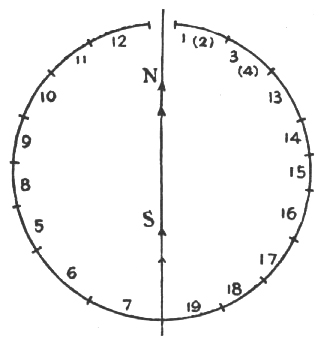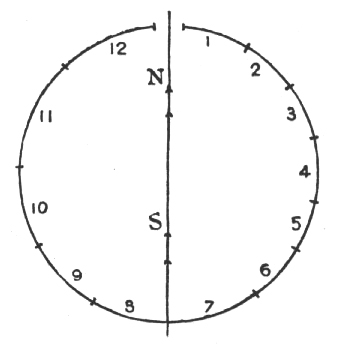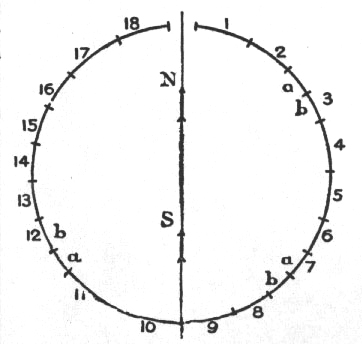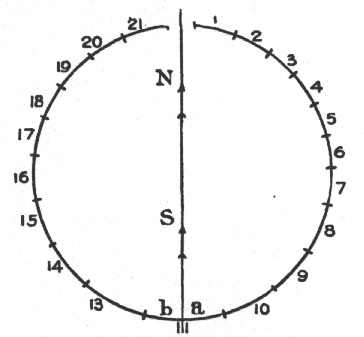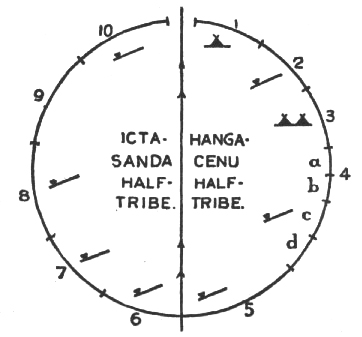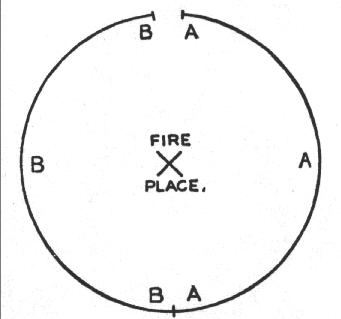Page 257
THE SOCIAL ORGANIZATION OF THE SIOUAN
TRIBES.
DEFINITIONS.
Very few white people, even those who have spent years among the Indians as missionaries and teachers, have any knowledge of the social organization of these tribes, which is based on kinship ties, as is the case in other tribes. One reason for this want of knowledge is the connection of the social organization with the religion of the people.
The tribes belonging to the Siouan linguistic family are the Dakota (wrongly styled the Sioux), Assiniboin, Omaha, Ponka, Kansa, Osage, Kwapa, Iowa, Oto, Missouri, Winnebago, Mandan, Hidatsa, Crow, or Absaroka, tribes whose priscan territories lay in the region now known as Dakota, Montana, Minnesota, Wisconsin, Nebraska, Iowa, Illinois, Kansas, Missouri, and Arkansas; the Biloxi, who were formerly near Mobile Bay; the Catawba, of South Carolina; the Tutelo, Sapona, Occanechi, etc., of North Carolina and Virginia.
Most of these tribes are still divided into gentes, each gens consisting of consanguinei, who reckon descent in the male line. Where descent is in the female line, the name clan is used instead of gens.
Several of the tribes are divided into half-tribes, and others are composed of phratries, each half-tribe or phratry being divided into gentes. In several of the tribes, each gens is composed of subgentes.
DAKOTA TRIBES.
The Dakota call themselves "Otceti cakowiⁿ," The Seven Fire-places, or Council fires, referring to their original gentes, now tribes, which are as follows: Mdewakaⁿtoⁿwaⁿ, Waqpe-kute, Waqpe-toⁿwaⁿ, Sisitoⁿwaⁿ, Ihanktoⁿwaⁿ, Ihanktoⁿwaⁿna, and Titoⁿwaⁿ.
The Mdewakaⁿtoⁿwaⁿ are the original Santees, but the white people, following the examples of the Yanktons, Tetons, and Yanktonnai, now extend the name to the Waqpe-kute, Waqpe-toⁿwaⁿ, and Sisitoⁿwaⁿ
Back to reference
Back to reference
Page 258
Mdewakaⁿtoⁿwaⁿ gentes. — The Mdewakaⁿtoⁿwaⁿ (Mdewakantonwan, of Riggs and others) are so called from their former habitat, Mdewakaⁿ, or "Spirit Lake," really, Mysterious Lake. The whole name means Mysterious (or Spirit) Lake Village. Rev. A. L. Riggs says that the name is of recent origin, but we find it used by De L'Isle as early as 1703.
1. Kiyuksa, Breakers (of the law or custom). So called because members of this gens disregarded the marriage law, taking wives within the gens. (Kee-uke-sah, in 1806, vide Lewis and Clark.)
2. Qe-mini-tcaⁿ, a hill covered with timber that appears to rise out of the water (Qe, mountain; mini, water; tcaⁿ, wood). Red Wing's village, a short distance from Lake Pepin, Minn., was so called. Sometimes called Qemnitca.
3. Kap'oja, Unincumbered with much baggage, "Light Infantry." "Kaposia, or Little Crow's village," in Minnesota, in 1852.
4. Maxa yute cni, Eat no geese.
5. Qeyata otoⁿwe (of Hake-wacte, the chief), or Qeyata toⁿwaⁿ (of A. L. Riggs), Village back from the river.
6. Oyate citca, Bad Nation.
7. Tiⁿta otoⁿwe (of Hake-wacte), or Tiⁿta toⁿwaⁿ (of A. L. Riggs), Village on the Prairie (tiⁿta). (Tin-tah-ton of Lewis and Clark, 1806.)
These seven gentes still exist, or did exist as late as 1880.
The Waqpe-kute. — Waqpe-kute, Shooters among the Leaves (i.e. among the deciduous trees, as distinguished from the Wazi-kute, Shooters among the Pines). The principal chief of the Waqpe-kute is Hu-caca, Red Legs.
After the Minnesota massacre, the Waqpe-kute and Mdewakaⁿtoⁿ-waⁿ were transported to Dakota Territory, and thence to what has been known as the Santee Reservation, in Knox County, Nebraska. The Waqpe-kute have gentes, but it has been impossible to gain their names.
The Waqpe-toⁿwaⁿ. — Waqpe-toⁿwaⁿ, Village among the Leaves. The gentes of this people; as given by the Rev. Edward Ashley in 1834, are as follows:
13. Iⁿyaⁿ-tceyaka atoⁿwaⁿ, Village at the Rapids (or Dam).
14. Takapsin toⁿwaⁿna, Village at the Shinney ground (Takapsitca, to play shinney).
15. Wiyaka otina, Dwellers on the sand.
16. Oteqi atoⁿwaⁿ, Village in the Thicket (oteqi).
17. Wita otina, Dwellers on the Island (wita).
Back to reference
Page 259
18. Wakpa atoⁿwaⁿ, Village on the River.
19. Tcaⁿ kaxa otina, Dwellers in Log (huts?).
These people are known to the whites as the Warpeton. We do not know what order they observed when they camped apart from the Sisitoⁿwaⁿ
The Sisitoⁿwaⁿ, or Sisseton. — The meaning of this name is uncertain. Rev. S.R. Riggs thought it was derived from sisiⁿ, Smelling of fish, or emitting a bad odor.
The Sissetons were evidently in seven divisions at one time, the Wita waziyata otina and the Ohdihe being counted as one, the Basdetce cni and the Itokaq-tina as another; the Kaqmi atoⁿwaⁿ, the Maniti, and the Keze as a third; and the Ti zaptaⁿ and Okopeya as a fifth.
When only a part of the tribe journeyed together, they camped thus: the Amdo-wapuskiyapi pitched their tents between the west and north, the Wita waziyata otina between the north and east, the Itokaq tina between the east and south, and the Kap'oja between the south and west. The Sisseton gentes are as follows:
1. Wita waziyata otina, Village at the North Island. 2. Ohdihe, an offshoot of No. 1, from ohdihaⁿ, to fall in an object endwise. 3. Basdetce cni, Do not split (the body of a buffalo) with a knife (but cut it up as they please). 4. (Offshoot of 3.) Itokaq tina, Dwellers at the South (itokaxa). 5. Kaqmi atoⁿwaⁿ, Village at the Bend (kaqmi, or kaqmiⁿ). 6. (Offshoot of 5.) Mani ti, Those who camp (ti) away from the village. 7. (Offshoot of 5.) Keze, Barbed like a fish-hook.
8. Tcaⁿ kute, Shoot in the Woods, a name of derision. These people resemble the Keze, whom Mr. Ashley styles "a cross clan." 9. Ti zaptaⁿ, Five lodges. 10. Okopeya, In danger. (An offshoot of 9.) II. Kap'oja, Those who travel with light burdens. (See
![]()
Page 260
No. 3 of Mdewakaⁿtoⁿwaⁿ). 12. Amdo wapuskiyapi, Those who lay meat on their shoulders (amdo) to dry it (wapuskiya) during the hunt.
Iha˝ktoⁿwaⁿ or Yankton gentes. — In 1878, Walking Elk, who can read and write his language, gave the gentes of his people in the following order: 1. Tcaⁿ kute, Shoot in the Woods. 2. Tcaxu, Lights or Lungs. 3. Wakmuha oiⁿ, Pumpkin Rind Earring. 4. Iha isdaye, Mouth Greasers. 5. Watceuⁿpa, Roasters. 6. Ikmuⁿ, some animal of the cat kind (lynx, wildcat, or panther). 7. Oyate citca, Bad Nation. 8. (Modern addition.) Wacitcuⁿ tciⁿtca, Sons of White Men, the Half-breed "band." But in August, 1891, Rev. Joseph W. Cook, a missionary to the Yanktons, obtained from several men the order of their gentes in the camping circle. They told him that their circle was not orientated, the line of march during the buffalo hunt determining the camping areas of the first and seventh gentes, who always camped in the van. On the right were the following: 1. Iha isdaye. 2. Wakmuha oiⁿ. 3. Ikmuⁿ. On the left were the following: 4. Watceuⁿpa. 5. Tcaⁿ kute. 6. Oyate citca. 7. Tcaxu. The modern addition is ignored in this arrangement.
Iha˝ktoⁿwaⁿna or Yanktonnai genies. — The Yanktonnai are divided into the Upper Yanktonnai and the Lower Yanktonnai, the latter being known also as the Hu˝kpatina, Those camping at one end or "horn" of the tribal circle, probably referring to a time when the Yanktonnai, Teton, and Yankton occupied one series of three concentric circles, and the Mdewakaⁿtoⁿwaⁿ, Wagpetoⁿwaⁿ, Waqpekute, and Sisitoⁿwaaⁿ occupied the series of four concentric circles.
The Upper Yanktonnai gentes are as follows: 1. Tcaⁿ ona, Shoot at Trees. 2. Takini, Improved in condition, as a lean animal or a poor man. 3. Cikcitcena, Bad ones of different sorts. 4. Bakihoⁿ, Gash themselves with knives. 5. Kiyuksa, Breakers (of the law or custom: see Mdewakaⁿtoⁿ, No. I). 6. Pa baksa, Cut Heads (some of these are on the Devil's Lake Reservation). 7. Name forgotten (probably the Wazi-kute, Shooters among the Pines, an offshoot of them now being known as the Hohe, or Assiniboin).
The Lower Yanktonnai or Hu˝kpatina gentes are as follows: 1. Pute temini, Sweat Lips (the gens of Maxa bomdu, or Drifting Goose). 2. Cŭⁿ iktceka, Common Dogs, Dogs. 3. Taquha yuta, Eat the scrapings of hides. 4. Saⁿ ona, Shot at something white. This name originated from killing a white buffalo. A Hu˝kpapa chief said that refugees or strangers from another tribe were so called. 5. Iha ca, Red Lips. 6. Ite xu, Burnt Face. 7. Pte yute cni, Eat no Buffalo (cows).
Titoⁿwaⁿ divisions. — The Teton were divided into seven gentes, which are now distinct tribes, named as follows : Sitcaⁿ-xu, Burnt
![]()
Page 261
Thighs, or Bois Brulés; Itazip-tco, Without Bows, or Sans Arcs; Siha sapa, Black Feet; Minikooju, Plant by the Stream, Minneconjou; Oohe noⁿpa, Two Boilings, or Two Kettles; Oglala, Ogalala (from oglala, to scatter her own); and Hu˝kpapa, Camp at the "Horn" of the tribal circle.
The Sitcaⁿxu, or Brulés, are divided locally into (1) Qeyata witcaca, People away from the water, the Highland or Upper Brulés; and (2) the Kud, or Kuta witcaca, Lowland People, Lower Brulés. The Sitcaⁿxu are divided socially into thirteen gentes, and a man of one gens can marry a woman of another. The following names for the Sitcaⁿ-xu gentle were given the author in 1880 by Tata˝ka wakaⁿ, Mysterious Buffalo-bull: 1. Iyak'oza, Lump, or wart, on a horse's leg. 2. Tcoka towela, Blue spot in the middle. 3. Ciyo ta˝ka, Big Prairie Chicken, or Grouse. 4. Ho-mna, Fish Smellers. 5. Ciyo subula, Sharp-tailed Grouse. 6. Kaⁿ-xi yuha, Raven Keepers. 7. Pispiza witcaca, Prairie Dog People. 8. Walexa uⁿ wohaⁿ, Boil food with the Paunch-skin (walexa). 9. Watceuⁿ-pa, Roasters. to. Cawala, Shawnees (the descendants of a Shawnee chief adopted into the tribe). 11. Iha˝ktoⁿwaⁿ, Yanktons (so called from their mothers, not an original Sitcaⁿ-xu gens). 12. Naqpaqpa, Take down leggings (after returning from war). 13. Apewaⁿ ta˝ka, Big Mane, so called from horses.
In 1884, Rev. W.J. Cleveland sent the author the following diagram, and the accompanying list of Sitcaⁿ-xu gentes: —
1. Sitcaⁿ-xu, Burnt Thighs (proper). 2. Kak'exa, Making a grating noise. 3. a. Hiⁿhaⁿ cŭⁿ-wapa, Towards the Owl Feather. 3. b. Cŭ˝;nkaha nap'iⁿ, Wears a Dog-skin around the Neck. 4. Hi-ha kaⁿhaⁿhaⁿ wiⁿ, Woman the Skin (ha) of whose
Teeth (hi) Dangles (kaⁿhaⁿhaⁿ). 5. Hŭ˝ku wanitca, Without a Mother. 6. Miniskuya kitc'ŭⁿ, Wears Salt. 7. a. Kiyuksa, Breaks, or Cuts, in two His own (custom, etc.; probably refers to the marriage law). 7. b. Ti glabu, Drums in his own Lodge. 8. WatceŭOⁿpa, Roasters. 9. Wagluqe, Followers, commonly called Loafers. A.L. Riggs thinks the word means "In-breeders." 10. Isaⁿyati, Santees. 11. Wagmeza yuha, Has Corn. 12. a. Walexa oⁿ wohaⁿ, Boils with the Paunch-skin. 12. b. Waqna, Snorts. 13. Oglala itc'itcaxa, Makes himself
![]()
Page 262
an Oglala. 14. Tiyotcesli, Dungs in the Lodge. 15. Wajaja, Osages(?). 16. Ieska tciⁿtca, Interpreter's sons (Half-breeds). 17. Ohe noⁿpa, Two Kettles, or Two Boilings. 18. Okaxa witcaca, Man of the South.
Itaziptco gentes. — According to Waanataⁿ, or Charger (1880,1884) these are the following: 1. Itazip-tco qtca, Real Itazip-tco, or Minica-la, Red Water. 2. Cina luta oiⁿ, Scarlet Cloth Earring. 3. Woluta yuta, Eat dried venison, or buffalo-meat, from the hind quarter. 4. Maz pegnaka, Wear (pieces of) Metal in the Hair. 5. Tata˝ka tcesli, Dung of a Buffalo-bull. 6. Cikcitcela, Bad ones of different sorts. 7. Tiyopa otcaⁿnuⁿpa, Smokes at the Entrance of the Lodge.
Siha sapa genies. — In 1880, Peji, or John Grass, gave the author the following as the names of the Siha-sapa gentes: 1. Siha sapa qtca, Real Black Feet. 2. Kaⁿxi cuⁿ pegnaka, Wears Raven Feather in the Hair. 3. Glagla hetca, Untidy, Slovenly, Shiftless ("Too lazy to tie their moccasins"). 4. Wajaje (Kill Eagle's band, named after the band of Kill Eagle's father, he being a Wajaje of the Oglala tribe). 5. Hohe, Assiniboin. 6. Wamnuxa oiⁿ, Shell Ear-pendant. In 1884, Rev. H. Swift obtained from Waanataⁿ, or Charger, the following list of the Siha-sapa gentes: 1. Ti zaptaⁿ, Five Lodges. 2. Siha-sapa qtca. 3. Hohe. 4. Kaⁿxi cuⁿ pegnaka. 5. Wajaje. 6. Wamnuxa oiⁿ. "There is no band called Glagla hetca."
Minikooju genies. — In 1880, Tatanka waⁿmli, or Buffalo-Bull Eagle, gave the author the names of Nos. 1, 2, 3, 5, 6, 7, and 8 of the following list. These were given in 1884, with Nos. 4 and 9, by No Heart, to Rev. H. Swift: 1. U˝ktce yuta, Eat Dung. 2. Glagla hetca, Slovenly. 3. Cŭ˝ka yute cni, Eat no Dogs. 4. Nixe ta˝ka, Big Belly. 5. Wakpokiⁿyaⁿ, Flies along the Creek (wakpa). 6. Iⁿyaⁿ-ha oiⁿ, Mussel-Shell Earring. 7. Cikcitcela, Bad ones of different sorts, or Very Bad. 8. Wagleza oiⁿ, Water-snake Ear-ring. 9. Waⁿ nawexa, Broken Arrows. This last gens is nearly extinct.
Oohe noⁿpa gentes. — Charger knew the names of only two gentes, which he gave to Rev. H. Swift in 1884: 1. Oohe noⁿpa, Two Boilings. 2. Ma waqota, Skin Smeared with Whitish Earth.
Oglala genies. — The first list was obtained in 1879 from Rev. John Robinson, and confirmed in 1880 by a member of the tribe: 1. Payabya. 2. Tapicletca. 3. Kiyuksa, Breaks his own (custom?). 4. Wajaja (see Siha-sapa list). 5. Ite citca, Bad Face, or Oglala qtca, Real Oglala. 6. Oiyuqpe (i.e. Oyuqpe of next list). 7. Wagluqe.
These were probably the earlier divisions of the Oglala; but in 1884 there were twenty-one of them, as shown in the following diagram and list, obtained from Rev. W. J. Cleveland: —
Page 263
1. Ite citca, Bad Face (under "Red Cloud"). 2. Payabyeya, Pushed aside (under Tacŭ˝ka kokipapi, They Fear even his Horse (wrongly called Man Afraid of his Horses). 3. Oyuqpe, Thrown Down, or Unloaded. 4. Tapicletca, Spleen of an animal. 5. Pe cla, Bald Head. 6. Tcex huha toⁿ, Kettle with Legs. 7. Wablcnitca, Orphans. 8. Pe cla ptetcela, Short Bald head. 9. Tacnahetca, Gopher. 10. I wayusota, Uses up by begging for, "Uses up with the Mouth." 11. Wakaⁿ, Mysterious. 12. a. Iglaka teqila, Refuses to Move Camp. 12. b. Ite Citca, Bad Face. 13. Ite citca etaⁿhaⁿ, Part of the Bad Face, "Face Bad From." 14. Zuzetca kiyaksa, Bit the Snake in Two. 15. Watceoⁿpa, Roasters. 16. Watcape, Stabber. 17. Tiyotcesli, Dungs in the lodge. 18 and 19. Wagluge, Followers, or Loafers. 20. Oglala, Scattered his own. 21. Ieska tciⁿtca, "Interpreter's" sons, Half-breeds.
According to Mr. Cleveland, the whole Oglala tribe had two other names, Oyuqpe, Thrown Down or Unloaded, and Kiyaksa, Bit it in Two.
Hu˝kpapa gentes.— The name Hu˝kpapa (sometimes written Uncpapa and Uncapapa) may be compared with Hu˝kpatina: both refer to the hu˝kpa of a tribal camping circle. 1. Tca˝ka oqaⁿ, Sore Backs (of horses), not the original name. 2. Tce oqba (tce has a vulgar meaning, or it may be a contraction of tceya, to weep); oqba, sleepy. 3. Tinazipe citca, Bad Bows. 4. Talo nap'iⁿ, Fresh-meat Necklace. 5. Kiglacka, Ties his Own. 6. Tcegnake okisela, Half a Breech-cloth. 7. Cikcitcela, Bad ones of different sorts. 8. Wakaⁿ, Mysterious. 9. Hŭⁿska tcaⁿtojuha, Legging Tobacco-pouch.
THE ASSINIBOIN TRIBE.
The Assiniboin were originally part of the Yanktonnai Dakota.
Lists of the gentes of this people were recorded by Maximilian, Hayden, and others; but the present writer suspects that they are inaccurate.
Page 264
| MAXIMILIAN | HAYDEN | UNKNOWN WRITER |
| Itscheabiné. Les gens des filles. |
Wi-ić-ap-i-nah. Girls Band. |
Wiciyanpina. 60 lodges, under Les Yeux Gris |
| Jatonabiné.
Les gens des roches. Stone Indians of the English. Call themselves "Eascab." |
I'-an-to'-an | Inyan tonwan. 50 Lodges, under Premier qui Volle. |
| Otaopabiné. Les gens des canots. |
Wah-tó-pap-i-na*h. | Wah-to-pan-ah. Canoe Indians, 100 lodges, under Serpent. |
| Watópachnato. Les gens de l'age. |
Wa*h-tó-pali-an-da-to. Gens du Gauché, or Left Hand. |
Wah-to-pah-han-da-tok. Old Gauché's gens. Those Who row canoes, 100 lodges, under Trembling Hand. |
| O-see-gah of Lewis and Clarke, Discoveries, p.43, 1806. | Wa*h-zi-ah, or To-kum'-pi. Gens du Nord. |
Waziya wicasta. Northern People, 60 lodges, under Le Robe de Vent. |
The following have not yet been collated — in Maximilian's list: Otopachgnato, Ies gens du large; Tschantoga, les gens des bois; Tanintauei, les gens des osayes; Chábin, les gens des montagnes. In Hayden's list: Min'-i-shi-nak'-a-to, gens du lac.
THE OMAHA TRIBE.
Ha˝gacenu gentes. — 1. Wejiⁿcte, Elk. 2. I˝ke-sabŭ, Black Shoulder, a buffalo gens. 3. Ha˝ga, Ancestral, or Foremost, a buffalo gens. 4. Çatada, meaning uncertain, in four subgentes: a. Wasabĕ-hit'ajĭ, Touch not the Skin of a Black Bear (Bear people). b. Waji˝ga çatajĭ, Eat no Small Birds, Bird people. c. Tʼe-Pʼa it'ajĭ, Touch not a Buffalo Head, Eagle people. d. Kʼe-'iⁿ, Carry a Turtle on the Back, Turtle people. 5. Kʼaⁿze, Wind people.
Ictasanda gentes. — 6. Maⁿ-çi˝ka-gaxe, Earth-Lodge Makers, Coyote and Wolf people. 7. Tʼe-sĭnde, Buffalo Tail; a buffalo calf gens. 8. Tʼa-da, Deer Head, a deer gens. 9. I˝gçe-jide, Red Dung, a buffalo calf gens. 10. Ictasanda, meaning uncertain ("Gray Eyes"?), refers to effect of lightning on the eyes. The last gens consists of Reptile Thunder and people.
Page 265
In the figure, the sacred tents of the Wejiⁿcte and Ha˝ga gentes are designated by appropriate designs; so also are the seven gentes which keep the sacred pipes of peace. The sacred tent of the Wejiⁿcte is the war tent, those of the Ha˝ga are the tents connected with the buffalo hunt and the cultivation of the ground. The diameter of the circle represents the road travelled by the tribe when on the buffalo hunt, 1 and 10 being the gentes in the van.
Omaha subgentes. — The I˝ke-sabĕ used to be in four subgentes. When the gens met as a whole, the order of sitting was that shown in Fig. 6. In the tribal circle, the Waçigije camp next to the Ha˝ga gens, and the other I˝ke-sabĕ people camp next to the Wejiⁿcte; but in the gentile "council fire" the first becomes last and the last first.
A. The Waçigije (Maze or Whorl), or Waqube gaxe aka, He who acts mysteriously, or who makes something mysterious.
B. The Wataⁿzi jide çatajĭ, Those who Eat no Red Corn. The Iekiçĕ, Criers. The Naqçe it'a-bajĭ, Those who Touch no Charcoal.
The Ha˝ga used to have four subgentes, but two of them, the Waçitaⁿ, or Workers, and the Ha tu it'ajĭ, Touches Green (corn) Husks, are extinct, the few survivors having joined the other subgentes. The remaining sub-gentes are called by several names each.
1. Tʼesaⁿ-ha-atʼaçicaⁿ, Pertaining to the Sacred Skin of a White Buffalo Cow, or Wacabe, the Dark Buffalo, or Ha˝gaqti, Real Ha˝ga, or Tʼeçeze çatajĭ, Do not eat Buffalo tongues.
2. Jnⁿ-ha-atʼaçicaⁿ Pertaining to the Sacred (cottonwood) Bark, or Waqçexe açiⁿ, Keeps the "Spotted object," the Sacred Pole, or Jaⁿ waqube açiⁿ, Keeps the Sacred Pole, or Tʼa waqube çatajiⁿ, Does not eat the Sacred Buffalo sides, or Miⁿxasaⁿ çatajĭ, kĭ Pʼetaⁿ çatajĭ, eat no Geese, Swans, or Cranes.
In the tribal circle, the Wacabe people camp next to the I˝ke-sabĕ gens, and the Waqçexe açiⁿ subgens camps next to the Wasabĕhit'ajĭ of the Çatada gens; but, in the Ha˝ga gentile assembly, the positions are reversed, the Wacabe sitting on the right side of the fire, and the Waqçexe açiⁿ on the left.
The Wasabĕ-hit'ajĭ subgens of the Çatada gens was divided into
![]()
Page 266
four sections: Wasabĕ, Black bear, Mikʼa, Raccoon, Maⁿtcu, Grizzly bear, and Pʼahiⁿ, Porcupine. Only the Wasabĕ and Mikʼa, or Qukʼa (Singers), survive.
The Waji˝ga çatajĭ subgens is divided into four sections, as follows: 1. Hawk people, who were under the chief Standing Hawk (now dead). 2. Blackbird people, under the chief Wajiⁿa-gahiga. 3. Starling, or Thunder people. 4. Owl and Magpie people.
The Kʼaⁿze gens is divided into at least two subgentes, Keepers of the Pipe, and Wind people. Lion, of the Deer Head gens, said that the Kʼaⁿze had four subgentes, but this statement was denied by Two Crows, of the Ha˝ga gens, in 1882.
Maⁿçi˝ka-gaxe subgentes, as given by Lion: 1. Mikʼasi, Coyote and Wolf people. 2. Iⁿ'ĕ waqube açiⁿ, Keepers of the Sacred Stones. 3. Niniba t'aⁿ, Keepers of the Pipe. 4. Miⁿxasaⁿ wet'ajĭ, Touch not a Swan.
Ca˝ge-ska, chief of the Maⁿçi˝ka-gaxe, named three subgentes, thus: 1. Qube, Mysterious person, a modern name (probably including the Mikʼasi and Iⁿ'ĕ waqube açiⁿ). 2. Niniba t'aⁿ. 3. Miⁿxasaⁿ wet'ajĭ.
The Tʼa-da are divided into four parts: 1. Niniba t'aⁿ, Keepers of the Pipe, under Lion. 2. Naqçe-it'ajĭ, Touch no Charcoal, under Ji˝ga-gahige. 3. Thunder subgens, under Pawnee Chief. 4 Deer subgens, under Sĭnde-xaⁿxaⁿ.
The Ictasanda gens was divided into four parts: 1. Niniba t'aⁿ, Keepers of the Pipe. 2. Real Ictasanda people. (Nos. 1 and 2 are now consolidated.) 3. Wacetaⁿ, or Reptile people, sometimes called I˝gça˝ga cage açiⁿ, Keepers of the Claws of a Wildcat. 4 Real Thunder people, or Those who do not Touch a Clam Shell, or Keepers of the Clam Shell and the Tooth of a Black Bear.
To be continued.J. Owen Dorsey.
| More Omaha Heritage E-texts |

